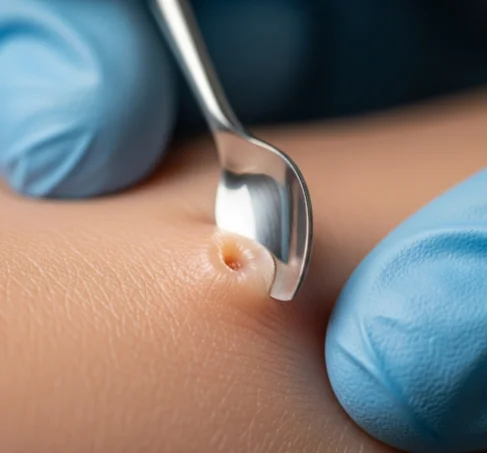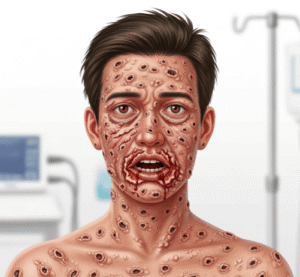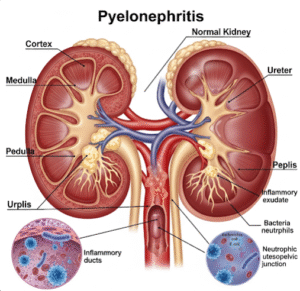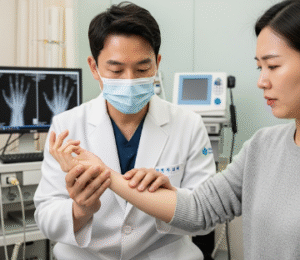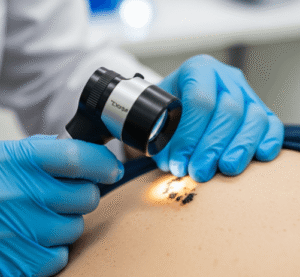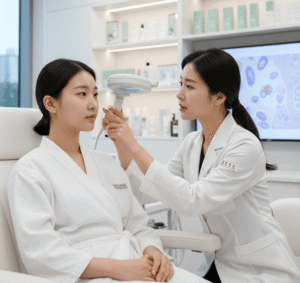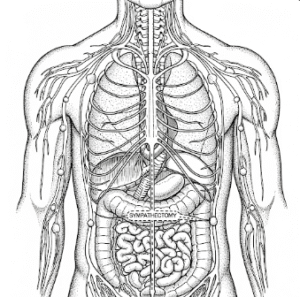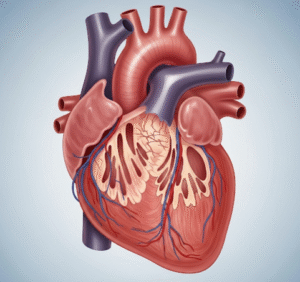What It Is
Defining Periorificial Dermatitis
→ Periorificial dermatitis (POD) is a common inflammatory skin condition that affects the areas around a child’s mouth, nose, and eyes.
→ It appears as clusters of small, red, bumpy rashes that may resemble acne or eczema but has distinct characteristics.
→ POD in children is often triggered by topical steroid creams, certain skincare products, or environmental factors.
→ In Korea, pediatric dermatology clinics provide gentle, child-safe treatments that focus on inflammation control, skin protection, and recurrence prevention.
Key Characteristics
- Small, red papules or pustules around the mouth, nose, or eyelids
- Skin between lesions often appears dry, flaky, or irritated
- Rash usually spares the skin directly at the lip border
- May cause mild itching, burning, or tightness
- More common in school-age children, but can also affect toddlers
Why It’s Done
Main Reasons for Seeking Care
➡ Accurate Diagnosis – POD is often confused with acne, eczema, or allergic rashes; correct diagnosis prevents mismanagement.
➡ Comfort for the Child – Redness and bumps may cause itching, stinging, or embarrassment.
➡ Avoiding Steroid Overuse – Many cases are worsened by prolonged use of topical steroids.
➡ Cosmetic Concerns – Parents seek treatment to restore smooth, healthy-looking skin.
➡ Prevention of Chronicity – Without care, POD can persist for weeks or months and become recurrent.
Alternatives
Non-Medical Options
- Gentle Cleansing → Washing face with mild, fragrance-free cleansers only.
- Discontinuing Steroids → Stopping the use of topical corticosteroids unless medically essential.
- Avoiding Triggers → Limiting use of heavy moisturizers, fluoride toothpaste, or irritating skincare.
- Barrier Creams → Using light, child-friendly protective creams to reduce irritation.
Medical Alternatives
→ If the rash does not resolve with simple avoidance measures:
- Topical Antibiotics (Metronidazole, Erythromycin) → Reduce redness and inflammation.
- Topical Calcineurin Inhibitors (Tacrolimus, Pimecrolimus) → Safe alternatives to steroids for sensitive skin.
- Oral Antibiotics (Azithromycin, Erythromycin) → In moderate to severe pediatric cases; chosen for safety in children.
- Topical Sulfur or Azelaic Acid → Sometimes used in older children for anti-inflammatory effects.
Preparation
Before Treatment
➡ Pediatric Dermatology Evaluation – Examination ensures it is POD and not acne, eczema, impetigo, or allergic dermatitis.
➡ History of Steroid Use – Many children develop POD after long-term steroid creams for eczema.
➡ Review of Skincare Routine – Products, toothpaste, or environmental triggers are assessed.
➡ Parent Counseling – Doctors explain that withdrawal from steroids may initially worsen symptoms before improvement.
➡ Lifestyle Planning – Guidance is given on gentle skincare, sun protection, and avoiding harsh products.
How It’s Done
Common Treatment Methods in Korea
1. Discontinuation of Steroid Creams
→ The most important first step.
- Doctors taper or stop steroid use depending on severity.
- Parents are educated about alternative safe creams.
2. Gentle Skincare Regimen
→ Pediatric dermatologists recommend:
- Mild, fragrance-free cleansers
- Light, non-comedogenic moisturizers
- Avoidance of heavy ointments or greasy creams
3. Topical Treatments
→ Safe, child-appropriate options include:
- Metronidazole cream → Reduces inflammation and redness
- Erythromycin gel → Child-safe antibiotic for localized lesions
- Pimecrolimus or Tacrolimus ointment → Especially for sensitive areas near the eyes
4. Oral Treatments
→ For widespread or resistant POD:
- Erythromycin or Azithromycin are preferred for children due to safety
- Doxycycline is avoided in children under 8 years due to risk of tooth staining
5. Adjunct Therapies
→ Some Korean clinics offer:
- Low-dose laser therapy for residual redness
- Soothing barrier masks designed for sensitive pediatric skin
Treatment Course
- Improvement usually begins within 2–4 weeks after discontinuing steroids and starting therapy.
- Complete resolution often occurs in 6–8 weeks.
- Some children may require maintenance skincare programs to prevent recurrence.
Recovery
Immediate Recovery
- Stopping steroids may cause temporary flare-ups in the first 1–2 weeks.
- Symptoms improve gradually with proper treatment and supportive care.
Long-Term Recovery
→ With consistent care, POD usually resolves completely.
→ Recurrence is possible if steroids or triggering skincare products are reintroduced.
→ Children often maintain clear skin with gentle cleansers, lightweight moisturizers, and sun protection.
Complications
Possible Risks Without Proper Care
- Persistent Rash → Lesions may last for months without treatment.
- Post-Inflammatory Pigmentation → Dark spots left behind after healing, especially in darker skin types.
- Emotional Impact → Visible rashes may affect confidence in school-age children.
- Steroid Dependency → Continued steroid use worsens long-term outcomes.
Possible Risks With Treatment
- Topical Irritation → Some creams may cause stinging or redness initially.
- Antibiotic Resistance → Rare, but possible with prolonged antibiotic use.
- Recurrence → POD may return if triggers are not controlled.
Treatment Options in Korea
Pediatric Dermatology Excellence
Korea has a strong reputation for child-friendly dermatology care, blending medical safety with cosmetic outcomes.
Why Korea Excels in Pediatric POD Care
➡ Gentle Protocols – Treatments are tailored to children’s sensitive skin.
➡ Parental Education – Parents are guided step by step in avoiding steroid misuse.
➡ Advanced Diagnostics – Dermoscopy and pediatric patch testing help rule out other skin diseases.
➡ Cosmetic Integration – Clinics provide options for reducing residual redness or pigmentation once lesions heal.
Popular Approaches in Korea
- Localized POD → Managed with topical antibiotics and barrier creams.
- Moderate POD → Treated with oral macrolide antibiotics and topical therapy.
- Steroid-Induced POD → Managed with careful steroid withdrawal and safe alternatives.
- Post-Healing Care → Sunblock, light moisturizers, and scar camouflage (if needed).
Patient Experience in Korea
- Consultations are child-focused, with emphasis on comfort and reassurance.
- Clinics provide customized skincare kits for pediatric POD management.
- Parents receive clear aftercare instructions and follow-up visits every few weeks.
- Korean dermatology culture strongly emphasizes natural skin recovery with minimal irritation.
Conclusion
Periorificial dermatitis in kids requires careful, gentle, and consistent management to avoid chronicity and recurrence.
In Korea, pediatric dermatologists excel at providing safe treatments, parent education, and cosmetic support that ensure both skin health and emotional well-being for children.
With steroid withdrawal, topical antibiotics, gentle skincare, and preventive strategies, children can achieve long-term remission and healthier skin.
For families seeking expert care, Korea offers some of the most advanced, child-focused, and reliable dermatology services for periorificial dermatitis.

